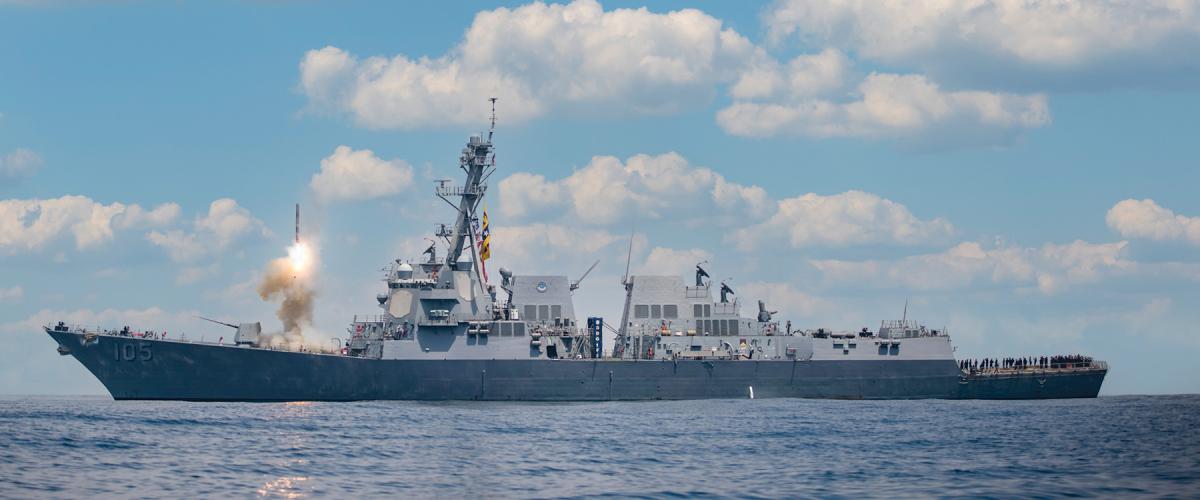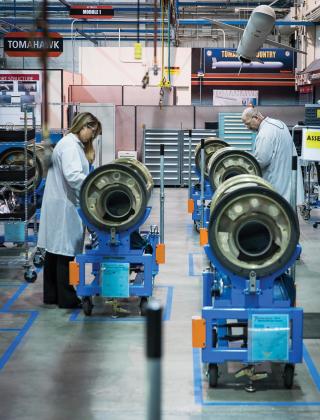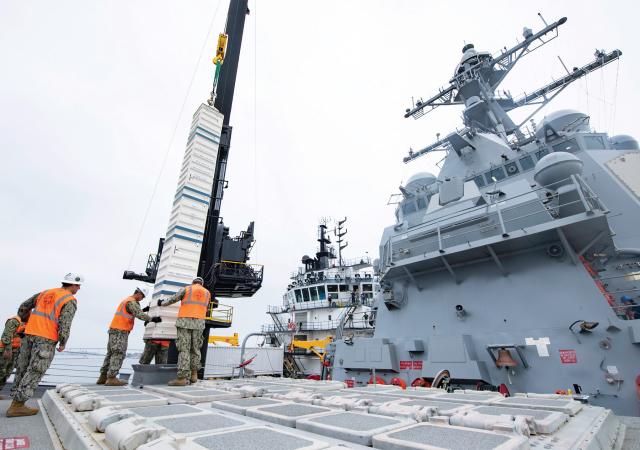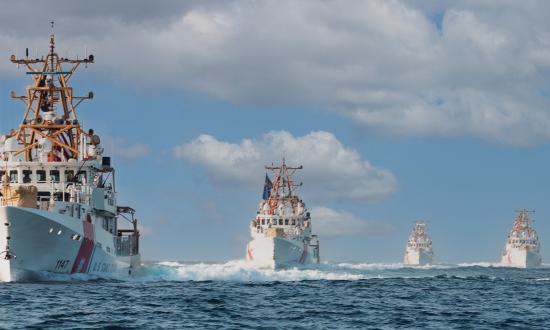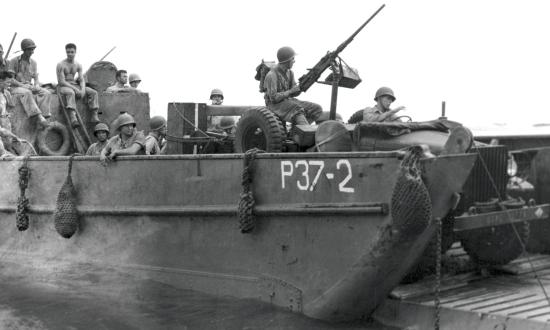Concerns about the number of vertical-launch cells the U.S. Navy could bring to a potential fight in the western Pacific dominate discussions in the defense world and in the pages of Proceedings. Even members of Congress have raised concerns about how many missile cells and platforms the Navy could bring to bear in a war with China.1 Ideas to boost numbers range from converting civilian cargo vessels into missile-firing arsenal ships, to building new classes of less-expensive surface vessels to placing long-range antiship cruise missiles on P-8 maritime patrol aircraft.2
What these solutions miss, however, is that if the Navy does not have enough missiles to sustain a fight in the western Pacific, the numbers of available vertical-launch system cells or long-range antiship missile (LRASM)–capable aircraft is meaningless. To address the problem, the Navy must acquire more precision-guided munitions now, and in large quantities over multiyear contracts, to sustain the industrial base.
Increase Missile Inventory
Just because the Navy does not presently have enough missiles to wage a long-term war against China does not mean it is not buying any. In its fiscal year (FY) 2021 budget proposal, the Navy planned to buy “850 missiles between the years 2020 and 2025 with the sole function of seeking and destroying enemy ships at range.”3 While this is a significant improvement over its FY2020 budget proposal, in which the Navy sought to buy only 88 antiship missiles, it could still be insufficient for a high-end conventional war.4
On 15 November 2022, in one of its largest missile barrages in more than two months, Russia fired at least 85 missiles against Ukrainian infrastructure—a number that would represent 10 percent of the Navy’s entire FY2021 budget request.5 If the Navy were to fire missiles at such a rate during a maritime conflict, its entire FY2021 procurement request for five years would be depleted in ten days.
While a land-based invasion of Ukraine by Russia is different than a maritime war with China would be, making comparisons difficult, there are still lessons to be learned. A maritime war involving submarines, surface ships, and aircraft would involve a variety of shipkills from torpedoes, sea mines, and missiles. The cost of antiship cruise missiles also would be a concern, but large missiles would be a part of an intense sea and air war between two highly sophisticated militaries.
The Navy does plan to boost SM-6 production to 180 missiles per year by 2024, but this is probably not enough and does not help with long-range strike, which would likely mark the first few days of combat.6 More precision-guided munitions will be necessary for a high-end conflict, and, should China decide to invade Taiwan before the end of the decade, the Navy will have insufficient stocks of high-value munitions at the start of conflict. Time is of the essence.
Invest in the Industrial Base
Increasing stocks ahead of a conflict will be challenging, but large, multiyear contracts to procure LRASMs, SM-6s, Tomahawks, and Naval Strike Missiles at maximum numbers is essential. The Department of Defense (DoD) also must invest in the munitions industry by helping companies build infrastructure to increase annual production rates and ensure a strong industrial base that can ramp up production in the event of a conflict.
Russia’s use of missile inventories in Ukraine should be a warning for DoD and the Navy. By March 2022, an “unnamed senior defense official” suspected that Russia was facing “some inventory issues with precision-guided munitions” after using hypersonic missiles “for tactical use against low-value targets.”7
Suspicions about declining Russian missile inventories have not abated. As recently as November 2022, Wall Street Journal bureau chiefs Stephen Fidler and Ann Simmons speculated that Russian precision-guided munition stocks had severely declined over the war, stating that Kalibr cruise-missile launches had “dropped significantly from an average of two dozen daily launches” in March to only 15 missiles in the entire month of October.8 Some believe the main cause for these weapon shortfalls is Russia’s inadequate investment in munitions’ supply chains and its industrial base—a fate the U.S. Navy could meet if it does not invest in acquisition capacity.9
It is imperative any changes the Navy makes are long-term. It is not enough to buy missiles in the short-term and expect industry to establish capacity for rapid expansion should the Navy need it in the future. After years of buying the absolute minimum, the United States has “right-sized” its munitions manufacturing.10 To keep the industrial base large enough to build the necessary stockpile for a future war, and capable of expanding its production capacity during a conflict, the Navy must demonstrate to the defense industry that its commitment to missile production will remain large and constant. Without this investment, there is little hope of establishing a “stable supply chain.”11
It is an expensive proposition: SM-6s are $4.3 million per unit, LRASMs cost $3.5 million per unit, Naval Strike Missiles are $2.2 million per unit, and the Tomahawk (Block V) is a relative steal at $1 million per unit.12 But these expenses must be borne. Fortunately for the Navy, when long-term, large-quantity purchase orders take effect, they usually bring 5–15 percent savings over the long term.13 Regardless of potential savings, it is important the Navy make these investments now to prevent shortages during a future conflict.
Buy Today, Win Tomorrow
There are other problems associated with missile logistics, such as the need for a greater focus on replenishment, especially at-sea replenishment. In addition, missile storage facilities in the western Pacific will be needed, as well as the ability to defend, harden, or hide those facilities. But first and foremost, the Navy must prioritize getting missiles into its stockpile before a war starts.
There are no alternatives to buying missiles. There are no quick fixes, work-arounds, or ways to avoid addressing the problem head on. If the Navy wants to deter or win a maritime conflict, it needs to invest, and it needs to start now. Any major change in DoD acquisitions takes years to take effect. If there is going to be a positive change in this munition dilemma, the Navy must start investing in missile production and guarantee long-term stability in those investments as soon as it can.
1. David Axe, “The U.S. Navy Finally Has a Universal Missile—and That Means More Firepower for War with China,” Forbes, 29 April 2021.
2. CAPT R. Robinson Harrison, USN (Ret.), Andrew Kerry, Kenneth Adams, Christopher Abt, Michael Venn, and Col T. X. Hammes, USMC (Ret.), “Converting Merchant Ships to Missile Ships for the Win,” U.S. Naval Institute Proceedings 145, no.1 (January 2019); CDR Bryan Clark, USN (Ret.), “Build a Fleet That Contests Every Inch,” U.S. Naval Institute Proceedings 148, no. 7 (July 2022); and John Keller, “Navy, Boeing Expanding Project to Equip P-8A Poseidon Maritime Patrol Aircraft with LSRAM Antiship Missile,” Military Aerospace Electronics, 29 November 2021.
3. David B. Larter, “As China Expands Navy, U.S. Begins Stockpiling Ship-Killing Missiles,” Defense News, 11 February 2020.
4. Larter, “As China Expands Navy.”
5. Julia Kesaieva, Casco Cotovio, Tim Lister, and Sana Noor Haq, “Wave of Russian Missiles Hit Ukraine after Zelensky Outlines Conditions for Peace at G20 Summit,” CNN, 15 November 2022.
6. Axe, “The U.S. Navy Finally Has a Universal Missile.”
7. Eric Tegler, “Russia May Be Showing It’s Running Low on Precision-Guided Munitions,” Forbes, 24 March 2022.
8. Serhii Korovayny, “Russia’s Munitions Shortages Raise Questions over How Long It Can Continue Ukraine War,” The Wall Street Journal, 22 November 2022.
9. “Russian A2/AD Capability Overrated,” FOI, 4 March 2019.
10. Tegler, “Russia May Be Showing It’s Running Low.”
11. Marcus Weisgerber, “U.S. Should Place Multiyear Munitions Orders to Protect Supply, Pentagon Arms Chief Says,” Defense One, 7 September 2022.
12. Joseph Trevithick and Tyler Rogoway, “Here Is What Each of the Navy’s Ship-Launched Missiles Actually Costs,” The War Zone, 11 December 2020; Joseph Trevithick, “Here Is What Each of the Pentagon’s Air-Launched Missiles and Bombs Actually Cost,” The War Zone, 18 February 2020; and David B. Larter, “The U.S. Navy Has an Upgraded Tomahawk: Here’s 5 Things You Should Know,” Defense News, 14 December 2020.
13. “R41909—Multiyear Procurement (MYP) and Block Buy Contracting in Defense Acquisition: Background and Issues for Congress,” Congressional Research Service, 9 December 2020.



